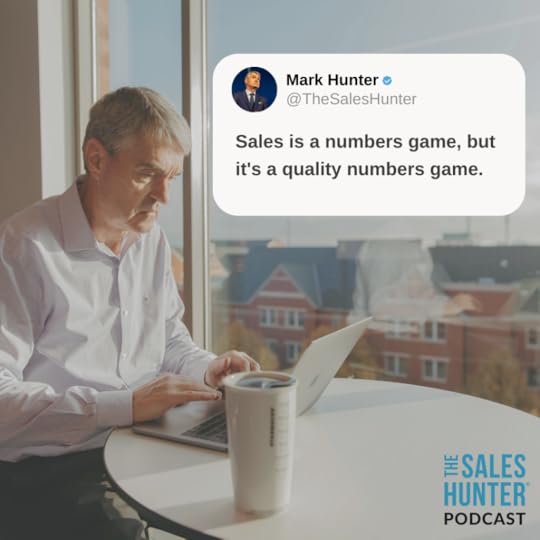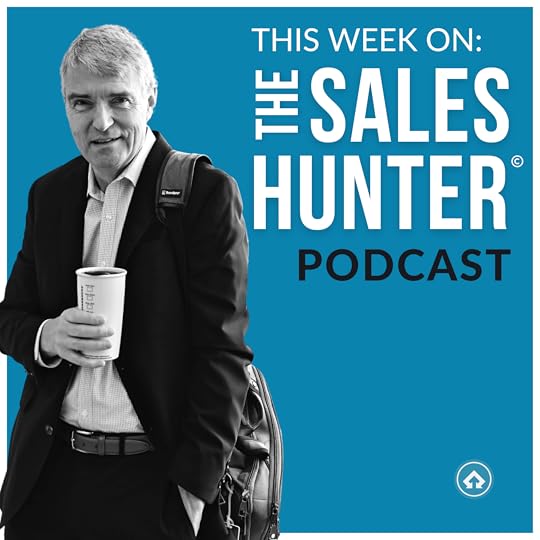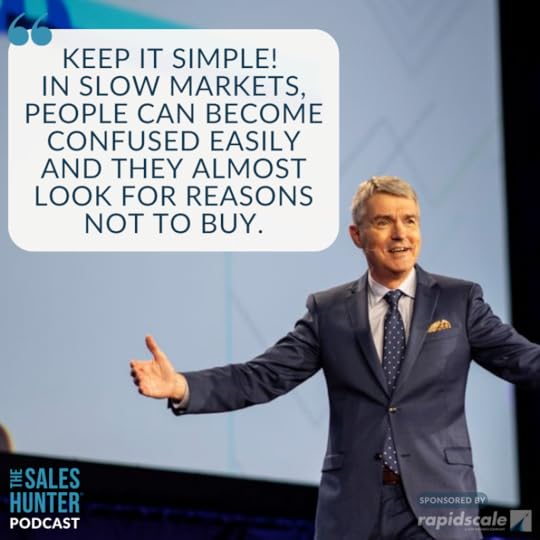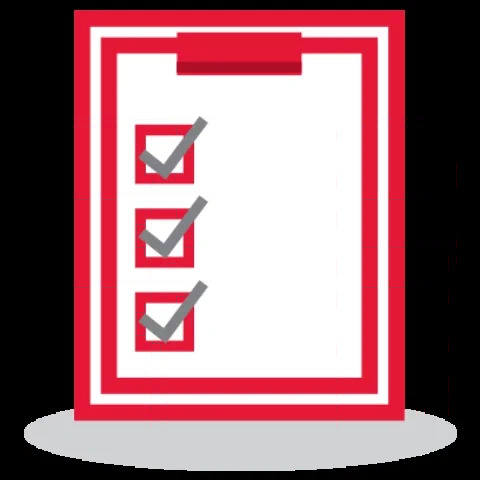Mark Hunter's Blog, page 5
February 11, 2025
How to Harness Your Strengths for Better Prospecting
Let’s boost your Sales Mindset.
Prospecting can be a challenge, but what if I told you it’s not just about the tactics—you also need the right mindset? When your mindset and prospecting strategies work together, magic happens. Here are 10 actionable tips to help you improve both.
1. Know You Can HelpWhen you’re making a prospecting call, remember that you’re not calling random people. You have a solution they need. Even if you don’t know everything about them yet, believe in the outcome you can create. You’re not just selling a product—you’re offering value.
2. Know Your StrengthsYou don’t need to know everything about your product to succeed. What matters most is knowing your strength—your personality, communication skills, and ability to build rapport. Focus on being genuine and human during each conversation.
 3. It’s Just a Call
3. It’s Just a CallDon’t overcomplicate things. Remember, it’s just a phone call. It’s not life or death—it’s one step in the process. Take the pressure off and approach each call with a relaxed attitude.
4. It’s Just a ConversationAt the end of the day, prospecting is just a conversation. You don’t need all the answers—just ask the right questions. If you don’t have the answer, promise to follow up. It’s all about building trust and laying the groundwork for next steps.
→ Read 5 Effective Follow-Up Techniques You Need to Know.
5. Have a Clear PlanBefore making a call, have a plan. Know what you want to achieve in each conversation and the steps you’ll take next. Setting goals for the call, the number of calls to make, and the follow-up actions will boost your confidence and effectiveness.
6. Measure Your ProgressTrack your calls and conversations. Use a simple method like a tick mark for each call, and separate conversations from voicemail. Measuring progress gives you a clear sense of accomplishment, even if you don’t close a deal right away.
 7. Set Quick Goals
7. Set Quick GoalsSet small, achievable goals like making five calls an hour. These short-term goals create momentum and keep you motivated. The sense of accomplishment will boost your confidence and keep you focused.
8. Start EasyEase into your prospecting calls by reaching out to existing customers or people who know you. These calls are less intimidating and can build your confidence before diving into colder prospects.
9. Always Build the Next TouchNever leave a conversation without a plan for the next step. Whether it’s a follow-up call, email, or text message, always have a clear next touch. This keeps the conversation going and ensures you’re building relationships over time.
10. Celebrate Your Successes!Even if you don’t close a sale, celebrate the small wins. Whether it’s a meaningful conversation or progress toward a next step, celebrate your effort. This positive reinforcement will strengthen your mindset and keep you motivated.


Ready to Master Prospecting?
Mindset and prospecting go hand in hand. When you combine the right attitude with these strategies, you’ll set yourself up for success. If you’re serious about becoming a better prospector, check out the Sales Hunter University and the Prospecting Masterclass.
You’ll get:
+ 9 Coaching Videos
+ a in-depth workbook
By the end you’ll have a prospecting plan that you’re confident in, and strengthened prospecting skills.
Get the masterclass today for $59.
 Using Goals to go from Average to Top Performer
.
Using Goals to go from Average to Top Performer
.How sales experts propel themselves beyond average by breaking their goals into actionable, strategic steps.
Find episode #281 wherever you download podcasts!
Transforming Leads into Loyal Customers w/ Andrew Barbuto+ Maintaining persistence during those slow periods
+ How focusing on customer feedback can lead to long-term success.
Episode #282 is out now!

Copyright 2025, Mark Hunter “The Sales Hunter” Sales Motivation Blog. Mark Hunter is the author of A Mind for Sales and High-Profit Prospecting: Powerful Strategies to Find the Best Leads and Drive Breakthrough Sales Results.
February 4, 2025
Overcoming Silence in Prospecting
Whether it’s ghosting or a lack of response, the key is persistence.
In this blog, I’ll explore 10 effective strategies that will help you turn silence into opportunities
1. Ask 5 Key Questions
Always have five relevant questions to ask, focusing on the prospect’s business, industry, and challenges. This positions you as a helpful resource, rather than just a salesperson.
Tip: Tailor your questions to reflect their specific business needs and pain points. For example, “What trends are shaping your industry this year?” or “How are you adapting to new challenges in your field?”
2. Share 5 Valuable Industry Facts
Provide relevant insights—trends, stats, or strategies—that could benefit the prospect. Offering value up front builds trust and credibility.
Example: “Did you know that X percentage of businesses in your industry have shifted to Y solution? This might be something worth considering for your business as well.”
3. Engage Other Stakeholders
If your main contact isn’t responding, reach out to other decision-makers or team members. This can give you more insights into their needs and increase your chances of success.
4. Build Awareness on Social Media
Social media is an excellent long-term strategy for prospecting. Don’t rely solely on cold calls or emails. Instead, leverage platforms like LinkedIn, Twitter, or Instagram to share valuable content that aligns with your prospect’s industry.
Be sure to engage on platforms where they’re most active.

5. Use Storytelling
Share success stories to make complex ideas relatable. Stories help prospects see how they can benefit, prompting them to engage.
By sharing success stories, you allow prospects to see themselves in the narrative, which can prompt them to reach out for more information.
Tip: Share relatable stories that reflect the challenges your prospect is facing. You might say, “I worked with another company in your industry, and they found success with X strategy. How are you currently handling this challenge?”
6. Create Continuous Value
Every interaction should offer something new, whether it’s insights, solutions, or relevant data. Focus on helping the prospect solve problems.
7. Show Personality
Be genuine in your communication. Whether it’s through phone calls, emails, or voicemails, your tone can build rapport and encourage responses.
Prospects are more likely to respond to a genuine, engaging person.
Tip: Use voicemail as an opportunity to express your personality and enthusiasm.

8. Respect Their Time and Boundaries
If a prospect asks to stop hearing from you, respect their wishes, but don’t give up entirely. Follow up later with value-driven content, not a sales pitch.
9. Be the Industry Expert
Contribute articles to trade publications, speak at industry events, or share expert insights on social media. Being recognized as an authority will make prospects more likely to engage with you.
10. Believe in Your Mission
Believe in what you offer and stay confident. Persistence, fueled by your passion for what you do, is key to overcoming silence and staying motivated.
Prospecting is a long-term game—be patient and stay focused on your prospects’ needs.
 How to Sell in a Slow Market
How to Sell in a Slow MarketDiscover the art of tailoring a smaller, more digestible version of your product or service to build trust with clients.
Find episode #279 wherever you download podcasts!
AI and Video’s Impact on Modern Sales Techniques w/ Jonathan ListerHow platforms like YouTube are reshaping the way content is consumed
+ the vital role video plays in modern sales strategies.
Episode #280 is out now!

Copyright 2025, Mark Hunter “The Sales Hunter” Sales Motivation Blog. Mark Hunter is the author of A Mind for Sales and High-Profit Prospecting: Powerful Strategies to Find the Best Leads and Drive Breakthrough Sales Results.
January 28, 2025
Creating Momentum with Your Prospecting
Boost your sales success with these ten practical tips for effective prospecting and keeping your momentum going.
It’s not just about making calls—it’s about cultivating the right mindset and applying consistent strategies. In this blog, I’ll dive into 10 actionable strategies to help you build momentum and achieve better results in your prospecting efforts.
https://youtu.be/HVj27dpR9LM1. Have a GoalHaving clear, achievable goals is essential for staying on track and measuring progress in your prospecting. Whether it’s the number of calls, emails, or meetings you aim to achieve in a day, setting goals helps keep your focus sharp.
Make sure your goals are realistic, as hitting smaller, achievable targets can generate positive momentum that propels you forward.
2. Make It Easy to WinIt may seem counterintuitive, but setting smaller, easier targets can actually help you build momentum faster. When you make your goals easier to hit, you create a sense of accomplishment and boost your confidence.
For example, if your target is to make just five phone calls and you hit that target, you’re more likely to make even more calls, resulting in positive reinforcement and momentum.
 3. Leverage Existing Customers
3. Leverage Existing CustomersYour existing customers can be an invaluable resource in creating momentum. Not only are they more likely to buy more from you, but they can also refer you to new prospects or provide helpful feedback.
Reconnecting with happy clients helps reinforce your credibility and energy. For instance, when I reached out to a client from six months ago, the positive response provided an instant boost to my momentum.
–> Read these 5 Follow-Up Techniques You Need to Know.
4. Engage with Partners/PeersCreating momentum doesn’t always mean talking directly to prospects. Engaging with partners and peers in your industry can also help. These conversations can lead to new opportunities, insights, or collaborations. Make it a habit to reach out to those who know your work. A simple question like, “How can I help you?” can open doors for mutual support and future business.
5. Set Hourly TargetsHourly targets help break down the day into manageable chunks and create a sense of urgency. Whether you aim to make three calls per hour or send ten emails, having hourly goals keeps you accountable and motivated. This practice encourages continuous action, making your overall prospecting more effective.
 6. Use Multiple Touches
6. Use Multiple TouchesIn sales, persistence is key. Don’t limit yourself to reaching out to just one person at a company. A single touchpoint isn’t always enough to get a response.
To increase your chances of success, use multiple touches across various channels (calls, emails, LinkedIn messages). Remember, it’s all about connecting with the right people in the right way.
–> Get the ‘Mastering Linkedin For Business Development’ Masterclass today for $279!
7. Repeat, Repeat, RepeatWhen you continuously touch base with leads, they’ll recognize your persistence, and you’ll increase the likelihood of building a strong relationship. Just remember to vary your approach each time to keep it fresh.
8. Celebrate SuccessEven small successes—like a call that goes through or a lead that replies—should be celebrated. When you celebrate each victory, it creates a momentum loop, encouraging you to keep moving forward.
 9. Banish Negative Thoughts
9. Banish Negative ThoughtsIf you allow negativity to creep in, it can derail your efforts. Instead, focus on your ability to help prospects solve problems. By keeping a positive attitude and blocking out negative distractions, you’ll stay energized and focused on your goals.
10. Don’t Stop ProspectingMomentum is easy to lose, especially if you take breaks from your prospecting efforts. Just like skipping workouts, stopping prospecting can make it hard to get back in the groove. To maintain consistency, don’t stop.
Keep prospecting every day, even when you face challenges, to stay sharp and continue building momentum.

Take it a Step Further!
Visit https://learn.thesaleshunter.com and enroll today in my Prospecting Masterclass for just $59.
Learn how to build a prospecting plan and craft your messaging to ensure a response.
 How to Bounce Back After Hearing ‘No’
How to Bounce Back After Hearing ‘No’Rejection isn’t the end—it’s just a stepping stone to future success
Find episode #277 wherever you download podcasts!
Harnessing the Power of Grit in Sales w/ Danielle CoboHow breaking down monumental goals into bite-sized tasks can make a world of difference.
& the power of setting personal KPIs to monitor progress.
Episode #278 is out now!

Copyright 2025, Mark Hunter “The Sales Hunter” Sales Motivation Blog. Mark Hunter is the author of A Mind for Sales and High-Profit Prospecting: Powerful Strategies to Find the Best Leads and Drive Breakthrough Sales Results.
January 22, 2025
5 Secrets to Making 2025 a Success
Many of us are setting our sights on making it our most successful year yet. Whether you’re a seasoned sales professional or just starting in the field, I’ve crafted a roadmap to guide you toward unparalleled success.
These aren’t just “secrets”—they’re fundamentals that every top-performing salesperson must follow.
1. Focus on Your Goals
In sales, staying focused on your goals is critical. It may seem basic, but so many salespeople get distracted by “shiny objects”—new opportunities, trends, or ideas that don’t align with their ideal customer profile (ICP). To achieve your sales goals, it’s essential to:
Know your resources—if an opportunity doesn’t fit your strategy, don’t waste time on it.Avoid time-wasting activities.
2. Push Yourself to a Higher Level
In 2025, push yourself to a higher level of achievement. To make significant strides, you need to:
Expand your network—connect with people outside your immediate circle.Invest in relationships—sales success often comes from the connections you build and nurture.Read and grow—continue developing your skills through books, podcasts, and other educational materials. The world is evolving rapidly, especially in an AI-driven environment, so ongoing professional development is a must.As Zig Ziglar once said, “The best way to get what you want is to help others get what they want.” By helping others achieve their goals, you will naturally open doors to new sales opportunities.
3. Be Disciplined with Your Time
Time is your most valuable resource in sales. If you don’t control it, it will control you. Here’s how you can master the discipline of your time:
Follow the 10 AM Rule: Accomplish something significant before 10 AM each day. This builds momentum and gives you the motivation to tackle the rest of your tasks.Time-block your day: Plan each hour carefully. This ensures you’re working on high-priority tasks, not getting distracted by the day’s interruptions. I separate my schedule into 2-hour time blocks. Simplify your routines: Like Steve Jobs, who wore the same outfit every day to avoid decision fatigue, simplify your daily choices to focus on what truly matters.Read these 10 Time Management Strategies for Salespeople and share with a colleague!
4. Follow up!
One of the biggest mistakes salespeople make is failing to follow up. Opportunities often slip through the cracks simply because of a lack of follow-up. Here’s why follow-up is non-negotiable:
Don’t assume a lack of response means disinterest. Follow up persistently—sometimes it takes multiple touchpoints to convert a lead into a sale.Your CRM system is your best friend for tracking follow-ups. Don’t let opportunities fall through the cracks.Commit to follow-ups before 10 AM—as part of my 10 AM rule, prioritize reaching out to prospects first thing in the morning.Pro tip: Make follow-up a daily habit. Consistent and timely follow-ups are key to turning leads into sales.

5. Your Mindset Matters
In sales, mindset is everything. Your mindset influences your actions, and ultimately your results. To ensure you succeed in 2025:
Start each day by reviewing your goals and the activities you need to accomplish.Surround yourself with positive influences. Avoid negativity and focus on the people who uplift and inspire you.Commit to repetition—when you combine the right habits, a positive mindset, and consistency, success follows naturally.Pro tip: Believing in your ability to succeed—and the potential of your prospects—will fuel your sales success. Remember, your sales goals should revolve around helping others achieve what they didn’t think was possible.

Special Offers to Accelerate Your Success
To take your sales to the next level in 2025, I’m offering two incredible resources:
The Making of a Mind for Sales Course : This online course includes 33 daily videos to help you develop the habits and mindset needed for sales success. It’s a complete package for building a sustainable sales career.Annual Sales Planning Program : This comprehensive online course includes 18 instructional videos and a 37-page workbook designed to help you craft a detailed annual sales plan that aligns with your goals.
Both courses will equip you with the tools and strategies you need to maximize your sales potential in 2025.
 Are You Persistent Enough?
Are You Persistent Enough?Learn the most important steps of the prospecting dance.
By understanding the value of consistent and innovative communication, you can maintain interest and stay ahead in the sales game.
Find episode #275 wherever you download podcasts!
Four Pillars for Email Prospecting Success w/ Tal BakerHow strong is your:
Deliverability, Lead Sourcing, Copywriting, & Data Quality?
Episode #276 is out now!

Copyright 2025, Mark Hunter “The Sales Hunter” Sales Motivation Blog. Mark Hunter is the author of A Mind for Sales and High-Profit Prospecting: Powerful Strategies to Find the Best Leads and Drive Breakthrough Sales Results.
January 14, 2025
5 Tips to Stop Getting Ghosted by Prospects
How many times have you been ghosted by a prospect? Don’t tell me you’ve never experienced a customer going radio silent on you—I’ve been there more times than I can count!
If you’re a salesperson, you’re probably familiar with the frustration of a great opportunity suddenly going dark. But you don’t have to face this anymore! In this post, I’ll walk you through 5 effective strategies to stop getting ghosted by prospects and customers.
https://youtu.be/pdsAdMLYitg1. Are You Qualifying the Right Prospects?
One of the main reasons you might be getting ghosted is that you’re targeting the wrong people. Sure, it may seem like a golden opportunity, but are they really your ideal customer? Understanding your Ideal Customer Profile (ICP) is crucial. Even if a prospect looks good on paper, they may not fit your ICP or, more importantly, they may not see how you can help them.
Qualifying prospects is a two-way street. You need to qualify them, but they must also qualify you. If they don’t see value in what you offer, they’ll go silent.
Just today, I got another email from a company trying to sell me something I don’t need. Of course, I went radio silent on them because they didn’t offer a solution I was interested in.
2. Is Your Value Proposition Clear?
A clear and compelling value proposition is essential to capturing your prospect’s attention. If your potential customers don’t understand how you can help solve their problems, they will tune you out.
For example, a company recently reached out to me multiple times after just one meeting. They assumed I was ready to buy—not even close!—their offer didn’t match my needs. Their value prop was unclear, and they failed to explain how their solution would benefit me.
Slow down and make sure your value proposition is crystal clear. Ensure prospects understand what you offer and how it can solve their specific pain points.

3. Bring New Value with Every Message
If you’re recycling the same message over and over, you’ll likely get ignored. Even if your value proposition is clear, if you’re not delivering fresh, relevant insights with each outreach, you’re just spamming your prospects.
I’ve had to send dozens of emails, texts, or LinkedIn messages to get a response, even with well-qualified prospects. The key is to continuously add new value—whether it’s a new insight, a case study, or a solution to a problem they may be facing. Stay persistent and keep the conversation going with fresh content to re-engage prospects.
Read: How Long Should You Stay Engaged with a Prospect?
4. Don’t Back Off—Keep Engaging!
If you genuinely believe you can help a prospect, you owe it to them to keep reaching out. Don’t back off just because they went silent. Ghosting doesn’t necessarily mean they’re not interested—it could mean they’re just too busy or dealing with other priorities. If you don’t follow up, you could be leaving money on the table.
I know it’s frustrating when prospects seem uninterested, but you’re doing them a disservice by not staying in touch.

5. Know Their Issues
Sometimes, prospects go radio silent because they’re dealing with internal issues—problems within their organization, financial pressures, or urgent matters. As a result, your offer may not be at the top of their mind.
The solution? Get to know their pain points. Establish deeper relationships with multiple stakeholders and learn about the challenges they’re facing. By understanding their issues, you can tailor your outreach to provide more relevant value.
When you offer solutions that directly address their specific pain points, you’re not just talking to one person; you’re engaging with a larger group within the organization. This will increase your chances of getting a response and making a sale.

Stop Getting Ghosted for Good
Consider investing in training that will help you refine your sales process. At Sales Hunter University, I offer a course that dives deeper into these five strategies and more.
By learning how to engage effectively with prospects and offer real value, you can stop getting ghosted and start closing more deals.
Get the Stop Getting Ghosted Masterclass today!
 How to Turn Meetings into Success
How to Turn Meetings into SuccessLearn how to turn “I’ll get back to you,” into a commitment.
Find episode #273 wherever you download podcasts!
How to Cultivate Genuine Business Connections w/ Casey HastenMark and Casey highlight the significance of making meaningful connections that leave a lasting impression.
Episode #274 is out now!

Copyright 2025, Mark Hunter “The Sales Hunter” Sales Motivation Blog. Mark Hunter is the author of A Mind for Sales and High-Profit Prospecting: Powerful Strategies to Find the Best Leads and Drive Breakthrough Sales Results.
January 7, 2025
The Ultimate Guide to Crafting a High-Impact Annual Sales Plan
5 Essential Steps to Build a Winning Annual Sales Plan
As we move into the new year, it’s time to ask yourself: Where are you with your annual sales planning? Many salespeople either don’t have a solid annual plan, or they’ve created one but haven’t fully committed to it. If you fall into one of these categories, don’t worry—this post is for you.
Today, I’ll walk you through five critical areas that many salespeople overlook when creating their annual sales plans. If you address these areas now, you’ll significantly improve your sales performance in the coming year.
1. Create a Solid Prospecting and Sales CadenceWhether you’re an account executive or a sales manager, prospecting cadence is essential to your success. Even if you’re not actively prospecting, you need a sales cadence or business-building cadence to stay organized and efficient.
A well-defined prospecting cadence means having a repeatable, scalable system for prospecting that aligns with your sales goals. This system should include daily and weekly metrics to help you stay on track. If you get your cadence right at the start of the year, you’ll set yourself up for long-term success.

Sales Hunter Tip: Make sure your cadence is efficient. Over time, you’ll refine your system to focus on the most critical elements, allowing you to consistently move prospects through your pipeline.
2. Master Time Management for Sales SuccessTime management is often overlooked when creating an annual sales plan, but it’s crucial. Many salespeople set ambitious annual goals without factoring in how much time they actually have.
To make your goals achievable, break them down into smaller, manageable pieces. Here’s how:
Set weekly and monthly targets based on your annual goals.Review your sales goals and prioritize tasks that contribute most to achieving those goals.Adjust your sales cadence to fit within your available time frame.If you don’t manage your time well, you’ll find yourself scrambling to hit your targets.
Read: How to Make the Most of Each Day by Mark Hunter, The Sales Hunter
3. Achieve Clarity of Your Offer and Value PropositionWhat do I mean by clarity of the offer? In other words, the customer can truly and quickly understand how you can help them.
Many salespeople fail to communicate a clear value proposition to their prospects. This lack of clarity often slows down the sales process.
Your value proposition is what you communicate at the beginning of your sales conversation, but clarity goes beyond that. Can the customer immediately understand how you can help them? If they don’t, they won’t move forward with your offer.
Sales Hunter Tip: Be clear, concise, and specific. Ensure that your prospects know how your solution directly addresses their pain points. A clear value prop is essential for closing deals faster.
4. Balance Your Sales PipelineOne of the most common mistakes in sales is failing to balance your pipeline. If you wind up with a few really big whales and a lot of minnows, you’ll probably want to start going after the minnows, the easy opportunities. Then you may not get to the whales until the end of the first quarter or the second quarter, and as a result, there’s not enough time in the year to convert them to customers. It’s a time management disaster.

A balanced pipeline consists of:
Large, medium, and small opportunities at different stages.A mix of short-term and long-term sales targets.Regularly scheduled prospecting to keep the pipeline full.By balancing your pipeline, you can ensure a steady flow of prospects and opportunities throughout the year. This also allows you to prioritize effectively and adjust your sales strategy as needed.
5. Prioritize Personal Balance and Well-Being
Surprisingly, a lot of salespeople say, what do you mean by personal balance? I’ve got to make understand how personally I can execute this. There are key holidays, key vacation periods. There may be a wedding or birth of a child, whatever it is, I’ve got to build that into my calendar.
Personal balance is also taking care of yourself. This is why I say physical fitness, mental fitness, and spiritual fitness are absolutely key. It’s one of the reasons why I have a very defined process as to how I start out my day. Every morning I work out, then I mentally challenge my brain with some deep reading. I work on my spiritual life in terms of spending a quiet time of reflection and thankfulness. What does that do? It all helps keep my personal balance in place.
 Get Help with Your Annual Sales Plan
Get Help with Your Annual Sales PlanIf you’re looking for more guidance on how to build an effective annual sales plan, I’ve got a course at the Sales Hunter University that can help. The course includes a 37-page workbook with actionable insights and videos that break down the entire process.
In this Annual Sales Plan Workshop, I’ll walk you through how to refine your sales cadence, set clear goals, and balance your pipeline. By the end of the course, you’ll have a personalized plan that will help you hit your targets consistently.
Start planning for success today—check out the course now and get ahead of the competition!
 Rethinking Your Approach to RFPs
Rethinking Your Approach to RFPsUncover the nuanced decision-making process that can transform your approach to RFPs from a mere bidding war to a calculated business opportunity.
Find episode #271 wherever you download podcasts!
Transforming Features into Compelling Storiesw/ Ernie HarkerCustomer testimonials are POWERFUL!
Ernie shares his insights on shifting from a feature-focused approach to storytelling that highlights customer experiences and benefits.
Episode #272 is out now!

Copyright 2025, Mark Hunter “The Sales Hunter” Sales Motivation Blog. Mark Hunter is the author of A Mind for Sales and High-Profit Prospecting: Powerful Strategies to Find the Best Leads and Drive Breakthrough Sales Results.
December 30, 2024
How to Stay on Top in Sales in 2025
As we head into the new year, ask yourself: Are you ready to be one of the top performers in your company? Whether you’ve been a top performer in the past or you’re striving to become one, it’s essential to master the right habits to stay on top.
In this post, I’ll challenge you with five essential strategies that will help you elevate your performance in the new year. Whether you’re already a high performer or just starting, these tips are crucial for everyone who wants to succeed in sales.
December 17, 2024
5 Effective Follow-Up Techniques You Need to Know
Effective follow-up is one of the easiest and most powerful ways to grow your sales.
Early in my sales career, I was terrible at following up. I was so focused on chasing new opportunities that I neglected my existing prospects and customers. Looking back, I can’t help but think of all the business I lost because I wasn’t diligent with follow-ups.
If you’re struggling with follow-up, or if you’re simply not sure how to build a strong follow-up system, this post is for you. Afterward, check out my Follow-Up Masterclass at the Sales Hunter University, which will help you develop your entire follow-up strategy.
1. Create a Consistent Follow-Up CadenceMany salespeople struggle to manage their prospects effectively, often losing track of key follow-ups. A solid sales cadence ensures you’re reaching out to prospects and customers at the right intervals without overwhelming them.
The key here is discipline and consistency. Sure, CRM tools can help automate part of the follow-up, but you need to add a personal touch. Automating your follow-up without any genuine engagement can feel cold and impersonal. Then it becomes a marketing automated function and you lose all credibility and all authenticity with prospects and with the customers. You need to be touching everything.
2. Bring New Value to Every Follow-UpNew value is essential for keeping your follow-ups fresh and engaging. Whether you’re following up with a prospect or an existing customer, adding value keeps the conversation going. This could mean offering new insights, useful resources, or sharing content that helps solve a problem for the customer.
For example, instead of just asking, “Did you get the quote?” offer new value like a blog post, industry insight, or even a book recommendation. One of my go-to strategies is sharing books I’ve found helpful, such as Atomic Habits by James Clear. I send them out to customers, not to sell, but to provide something of value. Building trust and authority is key in any relationship, and new value fosters both.
3. Engage Multiple Contacts
The bigger the opportunity, the more contacts you need within an organization. This is especially true with existing customers. Many salespeople make the mistake of relying on a single point of contact, but when that person leaves, your entire relationship with the account can be at risk.
By developing multiple contacts within a company, you’ll be better positioned to sustain and grow the business. More contacts mean more opportunities to sell and more stability in your relationships. It also helps you stay connected even if one contact moves on.
4. Keep It SimpleMany salespeople complicate things with long emails, complex offers, or overwhelming information. The simpler you keep your follow-up messages, the more likely the prospect or customer will respond.
Focus on clear, concise communication that reminds them of your value without overwhelming them with details. Always aim to keep follow-ups focused on one thing: how you can help them achieve their goals. This clarity will keep them engaged and interested.
5. Know When to Cut LooseSometimes, it’s best to walk away. After a few follow-up attempts, if a prospect is still unresponsive, it may be time to cut loose. It’s important to assess the opportunity’s lifetime value and decide whether it’s worth pursuing further.
After 5-6 follow-ups with no response from an opportunity that’s small potatoes, it may be time to walk away. On the other hand, if the opportunity is significant, stay in the game and keep pushing forward. Knowing when to let go is just as important as knowing when to persist.
Take Your Follow-Up to the Next Level
To master the art of follow-up, I highly recommend checking out my Follow-Up Masterclass at the Sales Hunter University.
This in-depth course will help you develop a comprehensive follow-up plan, giving you the tools and techniques to effectively nurture prospects and maintain strong customer relationships.
Click the link to get started on building your perfect follow-up strategy today.
 Reviving Sales Success through Calls and Voicemails
Reviving Sales Success through Calls and Voicemails Is cold calling really dead?
Or have we just forgotten how to harness the power of the phone in our sales strategies?
Find episode #265 wherever you download podcasts!
Rethinking Traditional Sales Training w/ Kelly RiggsWhy are only 25% of salespeople hitting the Mark?
Elevate your sales game by mastering strategic product demos and a well-executed discovery phase.
Episode #266 is out now!

Copyright 2024, Mark Hunter “The Sales Hunter” Sales Motivation Blog. Mark Hunter is the author of A Mind for Sales and High-Profit Prospecting: Powerful Strategies to Find the Best Leads and Drive Breakthrough Sales Results.
December 10, 2024
5 Annual Planning Mistakes
Are you planning for next year’s sales success?
If you’re not currently creating an annual sales plan, you’re missing out on a key strategy for growth.
I’ll walk you through five critical mistakes that salespeople often make when building out their annual plan. Stay with me until the end for a special offer to help you avoid these pitfalls and build a plan that drives success!
1. Underestimating Time in Your Annual Sales Plan
Many salespeople set ambitious goals, like acquiring new accounts or reaching specific revenue targets, but fail to realize that the 12-month calendar doesn’t always give you enough time to achieve everything. Remember, you’re not working with a full 365 days—plan for 10 months instead, since November and December often bring unexpected challenges.
When planning your sales goals, be very careful in how you estimate the amount of time that it’s going to take to do something. It’s always going to take you more time than you expect. Just accept that.
2. Failing to Conduct a SWOT Analysis
SWOT stands for Strengths, Weaknesses, Opportunities, and Threats, and it’s a powerful tool for understanding both your internal sales process and external market forces.
Strengths & Weaknesses: Look internally at your sales process, team capabilities, and resources.Opportunities & Threats: Identify external factors, like market trends, competition, and customer needs.Additionally, do a SWOT analysis for your major clients. You’ve got to go downstream with the customer. Understand their strengths, weaknesses, and market challenges to better align your offerings with their needs.
3. Not Fully Understanding Your Customer’s Issues
Too often, salespeople focus only on their own problems and goals, without considering the broader challenges their customers face. It’s essential to look beyond the surface and dig deeper into your customers’ issues.
Understanding their supply chain, competitive landscape, and potential regulatory or economic changes will give you the insights needed to anticipate their needs.
This is why focusing on your Ideal Customer Profile (ICP) is critical. When you know your customer’s pain points and market pressures, you’ll be able to tailor your sales strategy to align with their goals, not just yours.
Read these 9 Key Questions to Identify Your Perfect Customer.
4. Failing to Build a Buffer into Your Sales Plan
When setting sales targets, always build a buffer into your plan. If your goal is to secure $1 million in revenue, aim for $1.2 million or even $1.3 million. By doing this, you’ll create a cushion that accounts for unexpected hurdles or slower-than-expected customer decisions.
This buffer is particularly important when it comes to existing accounts. Don’t rely solely on your current clients for revenue—expect some accounts to underperform or reduce their spending. Having a buffer helps you stay on track even when things don’t go as planned.
5. Not Going Deep Enough in Your Planning
Another common mistake is creating an annual sales plan that’s too superficial. Your plan should dive deep into the specifics of what you need to do to hit your goals. Break down each target into actionable steps, including timelines, resources required, and potential roadblocks.
By going deeper into the details of your plan, you’ll uncover important questions like:
How can you ensure that customers will deliver on their expected purchases?What resources will you need to meet your targets?What’s the risk of unforeseen challenges, and how can you mitigate them? You want to make sure that you go deep enough in your annual plan, because this is going to save you a tremendous amount of time later on, and allow you to remain very efficient.
A more detailed plan helps you stay on course and improves your efficiency throughout the year. My annual planning program and workbook will help you do just that!

Annual Planning Masterclass
To help you avoid these five mistakes and build a solid annual sales plan that guarantees success, I’m offering an Annual Planning Masterclass. In this comprehensive 2.5-hour session, you’ll get access to a 37-page workbook that will guide you through the process of creating a sales plan you can execute with confidence.
In this masterclass, you’ll learn:
How to set achievable sales goalsHow to conduct a SWOT analysis for your business and customersStrategies to account for time and build a buffer into your planHow to break down your sales plan into actionable stepsIf you’re ready to stop falling short of your sales targets and make next year your best yet, click the link to register for the masterclass today—just $395! Even if you can’t attend the whole workshop live, you’ll get the playback.
Join me, Tuesday Dec. 17th 10am-12:30 p.m.
 Crushing Sales Goals
Crushing Sales GoalsEnsure you have a clear path from leads to successful sales calls.
Find episode #263 wherever you download podcasts!
Outbound Selling in the Age of AI w/ Anthony IannarinoCould AI in Sales leave more obstacles than opportunities?
This episode is a roadmap to enhancing your sales performance in today’s challenging markets.
Episode #264 is out now!

Copyright 2024, Mark Hunter “The Sales Hunter” Sales Motivation Blog. Mark Hunter is the author of A Mind for Sales and High-Profit Prospecting: Powerful Strategies to Find the Best Leads and Drive Breakthrough Sales Results.
December 3, 2024
How to Prevent Losing Customers: 4 Questions You Need to Ask
Key Questions to Ask for Effective Annual Sales Planning
These four questions help salespeople and companies refine their approach and grow their business during the annual sales planning process.
These questions are timeless—whether you’re planning for the new year or simply looking to improve your sales strategy. Don’t wait until the end of the year to ask these questions—start today to take your sales to the next level!
You can get a head start on 2025 by joining my Annual Planning program today! Scroll down for more info, and visit this link to enroll!
1. What Does the Marketplace Say About What I Sell?Understanding the perception of your product or service in the marketplace is key. This includes:
Customer reviewsWhat competitors are saying about youFeedback from customers who no longer buy from youWhat other industry experts or third parties are sayingToo often, companies hold a different view of themselves than the market does. You need to listen to the marketplace—sometimes from a neutral source—so you can get honest feedback.
2. What Do Potential Customers Who Didn’t Buy from Me Say?You need to understand why people turned down your offer. What made them decide not to buy from you?
While it’s natural to focus on current customers, you’ve got to understand the other side to uncover gaps in your value proposition. Maybe there’s a benefit you haven’t communicated well, or perhaps your competitors are doing a better job of meeting customer needs. Gathering feedback from people who didn’t purchase helps you identify areas for improvement.
3. What Triggers Referrals for My Business?Referrals are one of the most effective ways to grow your sales. But referrals don’t happen unless customers are genuinely happy with your product or service. So, why do your customers refer you?
What is the little piece of your business to which they say, I like this, I love this, and that’s why I’m going to refer.
By asking those who’ve referred you, you can pinpoint what part of your service or product sparked their enthusiasm. This feedback can help you enhance your offering and encourage more referrals.
Understanding the “referral trigger” can help you improve how you engage with customers and increase your chances of word-of-mouth growth.
4. Why Would a Customer Stop Buying from Me?Even if your product or service is typically a one-off purchase, understanding why customers stop buying is crucial.
Did they find a competitor with a better offer? Were they dissatisfied with your service?
Understanding why customers leave—and conducting exit interviews when possible—will help you prevent future losses. Sometimes a customer may stop purchasing for reasons that can be easily fixed, and by understanding this, you can improve your retention strategies.
Having tough conversations with customers who stop buying from me is the only way I’m going to get better.
 The Power of Annual Planning for Sales Success
The Power of Annual Planning for Sales SuccessThese four questions are part of the Annual Sales Planning Process I take companies and salespeople through each year. Addressing these questions helps you fine-tune your sales strategy and build a more effective approach to engage customers and drive growth.
If you want to dive deeper into this process and access my Annual Planning Workbook, check out this link!
Sign up to attend one of the two live webinars on: Dec. 6, 1-3:30 PM CST –OR- Dec. 17, 10:00 AM-12:30 PM CST
You’ll save your seat at the live event, and receive your annual planning workbook when you register here.
Let’s get you started with this essential sales planning tool! Don’t wait until it’s too late…
 Master Year-End Sales Calls
Master Year-End Sales CallsTransform client relationships with gratitude.
Step into the role of a partner and friend, and watch how your approach can change the way clients perceive you.
Find episode #261 wherever you download podcasts!
Building Influence in the C-Suite w/ David NewmanLearn the secret to capturing a CEO’s attention by aligning sales pitches with their vision
Episode #262 is out now!

Copyright 2024, Mark Hunter “The Sales Hunter” Sales Motivation Blog. Mark Hunter is the author of A Mind for Sales and High-Profit Prospecting: Powerful Strategies to Find the Best Leads and Drive Breakthrough Sales Results.
Mark Hunter's Blog
- Mark Hunter's profile
- 25 followers



